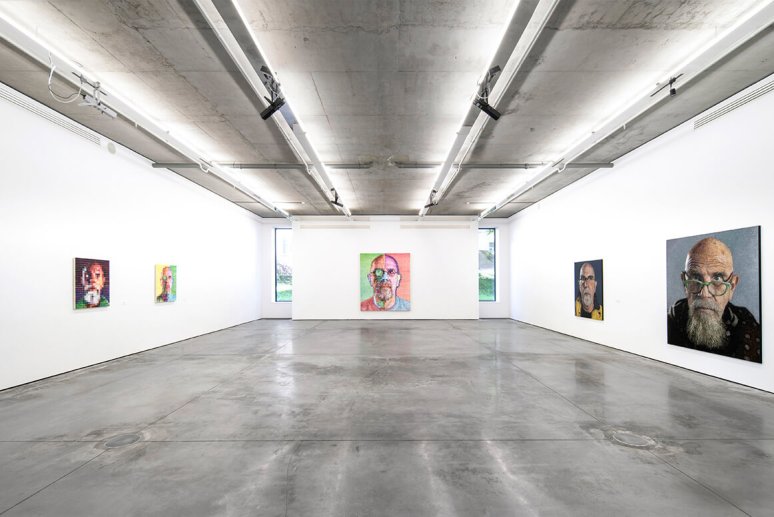18.06 — 27.11.2021InfiniteOne Man ShowChuck Close
Chuck Close. Infinite – Viewing Room
“To observe Close at work on one of the grid portraits is like watching a man who is patiently working his way through the world’s largest crossword puzzle. As the painting approaches completion, it’s as if the crossword has been miraculously transformed into biography, the components finding syntax that gives them cumulative meaning.”—Christopher Finch
Chuck Close
(1940 – 2021)
A legendary portrait painter and master of photorealism, Chuck Close is one of the most influential artists of his generation, renowned for his meticulous detail and innovative technique, which deeply impacted both American culture and the international art community.
An artist from an era of technological breakthroughs, Close controversially blurred the line between fine art and photography. Rather than relying on an expressive impulse or an academic tradition, he built his art upon his own rules and rituals. As an artist with a deep academic foundation, he pushed the concept of photographic realism in painting to the foreground and further popularized the use of art as a reflection of the power of individuality.
In an artistic journey that lasted more than 50 years, Close revolutionized the art scene, transforming the canons of academic portrait and experimenting in different forms—from Polaroid photography to oil painting, mosaic-tilework, and tapestry. He created portraits from tonal grids of fingerprints, pointillist dots, brushstrokes, paper pulp, and countless other media.
Close was one of the first artists to use the camera in the late 1970s to make photographs both as the basis for painted portraits and as standalone works. He devised his own iconic tool by placing a grid on the photograph and then transferring a proportional grid to large-scale canvases.
His signature method involved photographing a subject and transferring the image onto a large oil painting on canvas using a systematic, grid-based rubric. As the painting progressed, concentric colors were inserted into the cells, creating combinations that influenced the overall perception of color. The phenomenon of “optical blending” occurred as the human eye merged neighboring colors into a single hue. Close’s works relied on this process, where the eye combines colors in each cell at a micro level to form individual color information and then combines these mosaic-like bits at a macro level to reveal an image of a human face.
The rigor and mathematical precision of the grid has prompted numerous critics to label Close’s process as “scientific.” The flip side of this is the unexpected musicality afforded by the grid. Its repetitions create a precise and regular rhythm, while the variations in color represent a series of literally chromatic modulations. “I’m working with the color equivalent of a musical chord, a kind of color chord,” said Close of his compositions.
In the age of the selfie, the art of portraiture may appear to filter photographic reality. However, for Close, it went much deeper. Art became a means of communicating his pain, both physical and emotional, and a tool for celebrating his victory against the circumstances that tried to hinder his dreams. Beside the partial paralysis that confined him to a wheelchair since 1988, Close also had prosopagnosia (face blindness), which drove him to create portraits in the first place. He aimed to commit images of friends and family to memory, immortalizing the faces that mattered most to him. Despite his neurological conditions, he flourished as an artist, not in spite of them, but because of them.
“A face is a road map of someone’s life. Without any need to amplify that or draw attention to it, there’s a great deal that’s communicated about who this person is and what their life experiences have been.” — Chuck Close
In his Downtown Manhattan studio, there are portraits everywhere: Kate Moss, Brad Pitt, Lou Reed, Presidents Bill Clinton and Barack Obama, and Close himself — the movie stars, musicians, politicians, and artists all found their place in front of his camera. Each of them noted the duality of working with Close. On the one hand, it felt like a conversation with a close friend; on the other, it remained a formalized and rigorous process of creating a professional photograph.
“The immediacy of making the picture, changes the relationship between the subject and the artist, who together witness the image come into being after the photograph is pulled from the camera and the chemicals perform their function. You both work together to get something that you want out of it. Your subject knows what you’re trying to do.” — said Close.
The artist’s works portray the value and weight of each individual through hyperrealistic stylization. Creating a photo portrait could take Close several months, from concept development to the final print approval, while a painting might take about 12 to 14 months. Unlike most modern portraits, Close’s approach would not intend to flatter or embellish the person in the frame; instead, any imperfection becomes part of the biography, revealing a person’s truth.
Chuck Close received a National Medal of Arts and was appointed by President Obama to serve on his President’s Committee on the Arts and Humanities. He was a member of the American Academy of Arts and Letters and served on the boards of the most prestigious arts organizations. His artwork has been featured in hundreds of exhibitions as well as private and permanent museum collections around the world: Museum of Modern Art, New York; Tate Britain, London; Metropolitan Museum of Art, New York; Centre Pompidou, Paris; National Portrait Gallery, London; Hiroshima City Museum of Contemporary Art, Hiroshima; Suermondt-Ludwig-Museum, Aachen, Germany; and many others.
In cooperation with Pace Gallery
© Courtesy of the Artist, Pace Gallery and Gary Tatintsian Gallery









